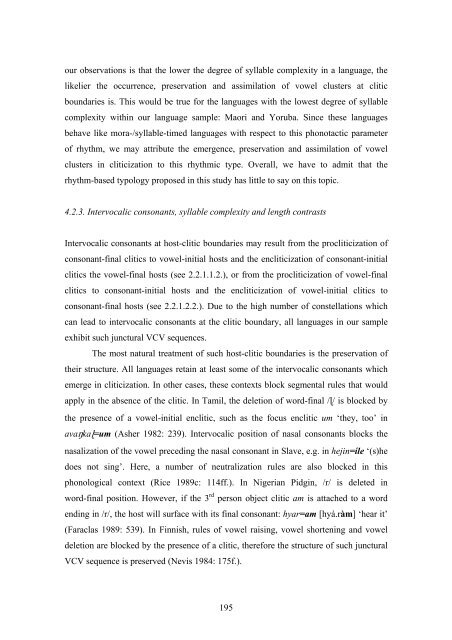View - KOPS - Universität Konstanz
View - KOPS - Universität Konstanz
View - KOPS - Universität Konstanz
Create successful ePaper yourself
Turn your PDF publications into a flip-book with our unique Google optimized e-Paper software.
our observations is that the lower the degree of syllable complexity in a language, the<br />
likelier the occurrence, preservation and assimilation of vowel clusters at clitic<br />
boundaries is. This would be true for the languages with the lowest degree of syllable<br />
complexity within our language sample: Maori and Yoruba. Since these languages<br />
behave like mora-/syllable-timed languages with respect to this phonotactic parameter<br />
of rhythm, we may attribute the emergence, preservation and assimilation of vowel<br />
clusters in cliticization to this rhythmic type. Overall, we have to admit that the<br />
rhythm-based typology proposed in this study has little to say on this topic.<br />
4.2.3. Intervocalic consonants, syllable complexity and length contrasts<br />
Intervocalic consonants at host-clitic boundaries may result from the procliticization of<br />
consonant-final clitics to vowel-initial hosts and the encliticization of consonant-initial<br />
clitics the vowel-final hosts (see 2.2.1.1.2.), or from the procliticization of vowel-final<br />
clitics to consonant-initial hosts and the encliticization of vowel-initial clitics to<br />
consonant-final hosts (see 2.2.1.2.2.). Due to the high number of constellations which<br />
can lead to intervocalic consonants at the clitic boundary, all languages in our sample<br />
exhibit such junctural VCV sequences.<br />
The most natural treatment of such host-clitic boundaries is the preservation of<br />
their structure. All languages retain at least some of the intervocalic consonants which<br />
emerge in cliticization. In other cases, these contexts block segmental rules that would<br />
apply in the absence of the clitic. In Tamil, the deletion of word-final /�/ is blocked by<br />
the presence of a vowel-initial enclitic, such as the focus enclitic um ‘they, too’ in<br />
ava�ka�=um (Asher 1982: 239). Intervocalic position of nasal consonants blocks the<br />
nasalization of the vowel preceding the nasal consonant in Slave, e.g. in hejin=íle ‘(s)he<br />
does not sing’. Here, a number of neutralization rules are also blocked in this<br />
phonological context (Rice 1989c: 114ff.). In Nigerian Pidgin, /r/ is deleted in<br />
word-final position. However, if the 3 rd person object clitic am is attached to a word<br />
ending in /r/, the host will surface with its final consonant: hyar=am [hyá.ràm] ‘hear it’<br />
(Faraclas 1989: 539). In Finnish, rules of vowel raising, vowel shortening and vowel<br />
deletion are blocked by the presence of a clitic, therefore the structure of such junctural<br />
VCV sequence is preserved (Nevis 1984: 175f.).<br />
195

















